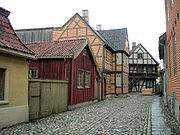
Norsk Folkemuseum
Encyclopedia

Bygdøy
Bygdøy or Bygdø is a peninsula on the western side of Oslo, Norway. Administratively, Bygdøy belongs to the borough of Frogner.Bygdøy has several museums, like the Kon-Tiki Museum, which shows all year long the legendary expeditions of Thor Heyerdahl; the Norwegian Museum of Cultural History ; the...
in Oslo
Oslo
Oslo is a municipality, as well as the capital and most populous city in Norway. As a municipality , it was established on 1 January 1838. Founded around 1048 by King Harald III of Norway, the city was largely destroyed by fire in 1624. The city was moved under the reign of Denmark–Norway's King...
, is a large open air museum
Open air museum
An open-air museum is a distinct type of museum exhibiting its collections out-of-doors. The first open-air museums were established in Scandinavia towards the end of the nineteenth century, and the concept soon spread throughout Europe and North America. Open-air museums are variously known as...
. Norsk Folkemuseum is one of Norway’s largest museum of cultural history.
The Norwegian Museum of Cultural History is situated near several other museums, including the Viking Ship Museum
Viking Ship Museum
Viking Ship Museum may refer to:* Viking Ship Museum * Viking Ship Museum...
; the Fram Museum
Fram Museum
The Fram Museum is a museum telling the story of Norwegian polar exploration. It is located on the peninsula of Bygdøy in Oslo, Norway.Fram Museum is situated in an area with several other museums, including the Kon-Tiki Museum; the Norwegian Museum of Cultural History; the Viking Ship Museum;...
; the Kon-Tiki Museum
Kon-Tiki Museum
The Kon-Tiki Museum is a museum at the archipelago Bygdøy in Oslo, Norway. It houses vessels and maps from the Kon-Tiki expedition, as well as a library with about 8000 books. It was opened in a provisional building in 1949. In 1957, the current building—designed by architects F. S. Platou and Otto...
; and the Norwegian Maritime Museum
Norwegian Maritime Museum
The Norwegian Maritime Museum , previously known as the Norsk Sjøfartsmuseum, founded in 1914, is located at Bygdøynesveien on the Bygdøy peninsula, on the western side of Oslo, Norway....
;.
History
It was established in 1894 by librarian and historian, Hans Aall (1867-1946). It contains over 150 buildings which have been relocated from different districts of NorwayNorway
Norway , officially the Kingdom of Norway, is a Nordic unitary constitutional monarchy whose territory comprises the western portion of the Scandinavian Peninsula, Jan Mayen, and the Arctic archipelago of Svalbard and Bouvet Island. Norway has a total area of and a population of about 4.9 million...
. Reidar Kjellberg
Reidar Kjellberg
Anders Reidar Kjellberg was a Norwegian art historianand museum director.-Biography:Anders Reidar Kjellberg was born in Fredrikstad in Østfold county, Norway. Kjellberg took his final exams in 1924 and began studying theology. However, he soon found out that he was more interested in the history...
became Director of the museum in 1947 and remained museum director until he retired in 1974.
Among its more significant buildings are Gol stave church
Gol stave church
Gol Stave Church is a stave church originally from Gol, Hallingdal, Norway. It is now located in the Norwegian Museum of Cultural History at Bygdøy in Oslo, Norway. -Description:...
from the 13th century which incorporated was into the Norwegian Folk Museum in 1907. The Gol Stave Church is one of five medieval buildings at the museum, which also includes the Rauland cabin (Raulandstua) from the 14th century, and the 18th century tenement building relocated from historic Wessels gate 15 in Oslo
Oslo
Oslo is a municipality, as well as the capital and most populous city in Norway. As a municipality , it was established on 1 January 1838. Founded around 1048 by King Harald III of Norway, the city was largely destroyed by fire in 1624. The city was moved under the reign of Denmark–Norway's King...
. In 1951, the Sami collection in the Ethnographic Museum of the University of Oslo
University of Oslo
The University of Oslo , formerly The Royal Frederick University , is the oldest and largest university in Norway, situated in the Norwegian capital of Oslo. The university was founded in 1811 and was modelled after the recently established University of Berlin...
was transferred to thr Norsk Folkemuseum.
The museum also possesses a large photographic archive, including a significant portion of the works of Anders Beer Wilse
Anders Beer Wilse
Anders Beer Wilse was a Norwegian photographer whose photography visually documented Norway in the early to mid-20th century....
. In 2004, the administration of the adjacent Bygdøy Royal Estate
Bygdøy Royal Estate
Bygdøy Royal Estate occupies a large part of the northwestern part of the Bygdøy peninsula in Oslo, Norway. It is the official summer residence of the King of Norway.- History :The estate originally belonged to the Cistercian monastery on Hovedøya...
was transferred to the museum. In recent years, research has focused on building and furniture, clothing and textiles, technical and social culture, working memory and Sami
Sami people
The Sami people, also spelled Sámi, or Saami, are the arctic indigenous people inhabiting Sápmi, which today encompasses parts of far northern Sweden, Norway, Finland, the Kola Peninsula of Russia, and the border area between south and middle Sweden and Norway. The Sámi are Europe’s northernmost...
culture.
Other sources
- Hegard, Tonte Hans Aall - mannen, visjonen og verket (1994) ISBN 82-7631-023-0
- Tschudi-Madsen, Stephan, På nordmanns vis : Norsk folkemuseum gjennom 100 år (1993) ISBN 82-03-16715-2

